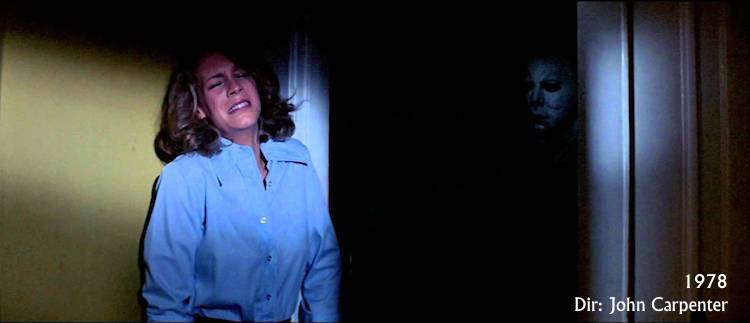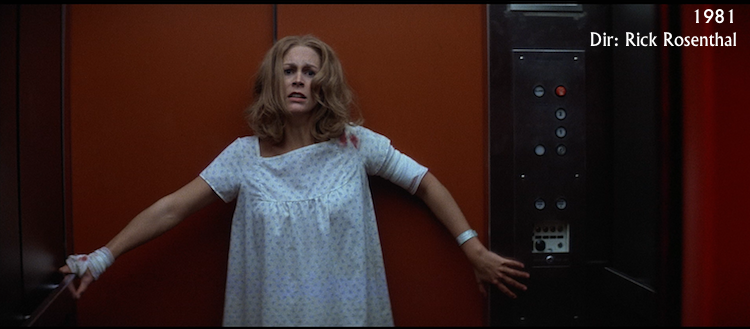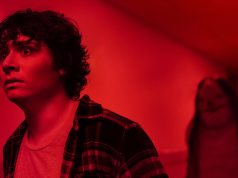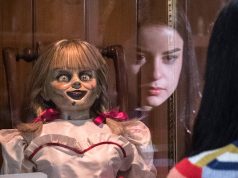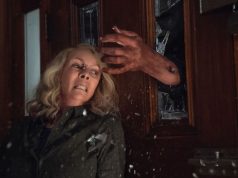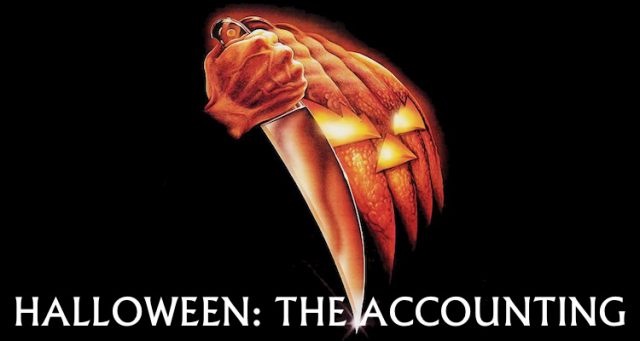
Since 1978, Halloween hasn’t just been a day to worship Satan and eat small candy bars. It’s also been a celebration of a long-running, highly influential film series about a masked killer: Batman.
Just kidding. Trick-or-treat! It’s “Halloween,” John Carpenter’s seminal stab-fest that was subsequently ripped off by “Friday the 13th,” a lot of others, and its own inferior sequels. Borrowing concepts from prototypes like “Psycho” and “Peeping Tom” (both 1960), as well as gruesome grindhouse fare like “The Texas Chain Saw Massacre” (1974), “Halloween” was the first modern “slasher” movie, launching a sub-genre that dominated horror through the ’80s (when they were America’s chief export) and into the ’90s.
The “Halloween” franchise consists of eight movies — we’re not counting Rob Zombie’s reboot and sequel, because screw them — and the most recent one is 15 years old. Yet they remain part of the zeitgeist, a reference point even for casual movie fans and people who don’t like horror movies.
And yet … how much do we really know about them? How obsessively have we analyzed the details? Not obsessively enough, it seems to us! So here’s a film-by-film breakdown of the story, the scares, and the stabbings that have made us Michael ad-Myer-ers for almost 40 years.
(Again, Rob Zombie’s 2007 remake and its 2009 sequel are not included purely out of spite.)
For more detailed statistics, including a complete list of Michael’s victims, see Part 2.
 Some notes on methodology…
Some notes on methodology…
Kills: Only Michael’s are counted. Offscreen kills are included if they are confirmed within the movie. Kills confirmed only in the novelizations and comic books do not count. Dog murders count.
KPH: Kills per hour. Total kills divided by the runtime (not including credits or flashbacks) in hours (e.g., 85 minutes = 1.42 hours).
Jump scares: Defined as a moment when a character (and usually also the audience) is startled by something that proves to be un-scary, usually (but not necessarily) accompanied by a musical sting on the soundtrack.
Michael’s musical theme/Michael breathing: Counted once per scene.
Michael vanishes: Instances where Michael is there one second, gone the next, as if supernaturally. Imaginary sightings are included (it’s too hard to tell which ones are definitely imaginary), but instances where there’s enough time between Michael’s presence and his absence for him to have simply walked away like a normal person are not.
Halloween
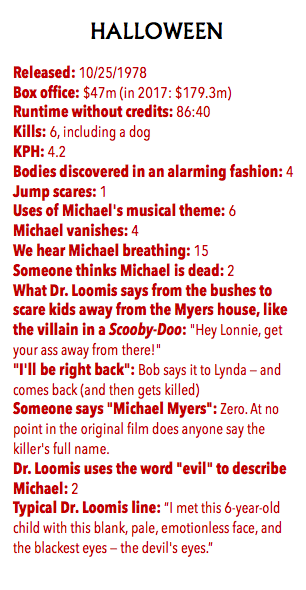 THE MOVIE: The setting is Haddonfield, Ill., on Oct. 31, 1978 (a Tuesday, by the way). Exactly 15 years earlier, 6-year-old Michael Myers stabbed his sex-having sister to death. Now, as a 21-year-old who’s called a 23-year-old in the closing credits, he has escaped from a mental institution and returned to steal his sister’s gravestone and, as long as he’s in town, kill some more teenagers.
THE MOVIE: The setting is Haddonfield, Ill., on Oct. 31, 1978 (a Tuesday, by the way). Exactly 15 years earlier, 6-year-old Michael Myers stabbed his sex-having sister to death. Now, as a 21-year-old who’s called a 23-year-old in the closing credits, he has escaped from a mental institution and returned to steal his sister’s gravestone and, as long as he’s in town, kill some more teenagers.
Laurie Strode (Jamie Lee Curtis) is a virginal high school student babysitting young Tommy Doyle when Michael Myers shows up to murder them all. On his heels is Dr. Sam Loomis (Donald Pleasence), who has been Michael’s psychiatrist ever since the blood-covered lad arrived at the nuthouse 15 years ago. Loomis is certain that Michael is an irredeemably evil, soulless monster, even though Michael hasn’t said a word to anyone in 15 years. So either Loomis just really has a good eye for this sort of thing, or else Michael is keeping a vivid diary that Loomis has read.
The film ends with Loomis shooting Michael until he (Michael) is dead, whereupon he (Michael) vanishes because he wasn’t dead after all, suckers!
NOTES: Haddonfield’s Halloween traditions are unusual. A few kids go trick-or-treating in mid-afternoon, after which they all stay home with babysitters while their parents go to parties. My theory is that John Carpenter and Debra Hill (who co-wrote and produced the film with him) had never celebrated Halloween and had only read about it in an encyclopedia. (Wait’ll we get to H3, where they think kids observe Halloween by wearing one of three identical prefabricated masks!) There’s also talk of the homecoming dance being “tomorrow” — i.e., Wednesday, Nov. 1 — which makes me think Carpenter and Hill did not go to high school, either.
Halloween II
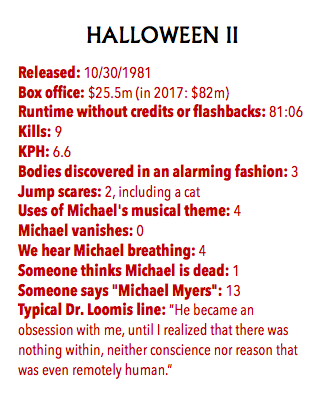 THE MOVIE: Picking up exactly where the first one left off, most of H2 is set at Haddonfield Memorial Hospital, which is staffed by one (1) doctor (who is drunk) and a few nurses and has no patients other than Laurie Strode. (The nursery is full of newborns, but their mothers evidently bolted as soon as the cords were cut.) Michael Myers is pursuing Laurie specifically for some reason, which reason turns out to be that she is his sister and he’s keen on killing all of his relatives. It’s sort of his “thing.” Brief glimpses of Laurie’s childhood confirm that she was adopted by the Strodes and once visited young Michael at the nuthouse, and that all of this was totally made up later to justify having Michael continue to pursue her in the sequel.
THE MOVIE: Picking up exactly where the first one left off, most of H2 is set at Haddonfield Memorial Hospital, which is staffed by one (1) doctor (who is drunk) and a few nurses and has no patients other than Laurie Strode. (The nursery is full of newborns, but their mothers evidently bolted as soon as the cords were cut.) Michael Myers is pursuing Laurie specifically for some reason, which reason turns out to be that she is his sister and he’s keen on killing all of his relatives. It’s sort of his “thing.” Brief glimpses of Laurie’s childhood confirm that she was adopted by the Strodes and once visited young Michael at the nuthouse, and that all of this was totally made up later to justify having Michael continue to pursue her in the sequel.
Meanwhile, Dr. Loomis is running around Haddonfield yelling about how dangerous Michael Myers is. To help out, he points a gun at a mask-wearing teen who isn’t Michael, causing the teen to run into the street and get smashed between two cars and blown up. (The teen turns out to be Ben Tramer, mentioned in H1 as the boy Annie set Laurie up with for tomorrow’s homecoming dance. Loomis basically ruins everything.) In defiance of what would become slasher tradition, the cops actually listen to Loomis, though they also let him wave a gun around and chase innocent youths into traffic.
Michael murders some nurses, paramedics, and cops on his way to Laurie, then fails to kill her, making the whole day a bust for him. Loomis shoots him a few more times, and then Laurie shoots him in the face, but all it does is blind him, so Loomis blows up the room containing himself and Michael and this finally does the trick, or seems to.
 NOTES: It took three years to slap a sequel together; in those days, a low-budget horror film returning a huge profit didn’t automatically trigger a sequel like it does now. By this time, Jamie Lee Curtis deserved top billing with Donald Pleasence, so they shared it the way Ted Danson and Shelley Long did on “Cheers.”
NOTES: It took three years to slap a sequel together; in those days, a low-budget horror film returning a huge profit didn’t automatically trigger a sequel like it does now. By this time, Jamie Lee Curtis deserved top billing with Donald Pleasence, so they shared it the way Ted Danson and Shelley Long did on “Cheers.”
Loomis is very proud of having shot Michael six times, and he tells everyone who will listen. Thing is, it’s not true — he shot him seven times. Roll the tape!
(When these same events happened at the end of H1, it was indeed six shots. For some reason an extra shot was added when the scene was recreated for the sequel.)
Speaking of miscounts, someone says the body count at the hospital is “ten, so far,” but Michael only killed eight people at that location that we know of. Perhaps there were others, or perhaps some patients died from neglect.
The stereotype is that people in these movies get killed after they have sex, but nurse Karen and paramedic Budd are murdered after only fooling around a little. Michael Myers has a zero-tolerance policy for teen horniness.
Continue reading at Crooked Marquee

